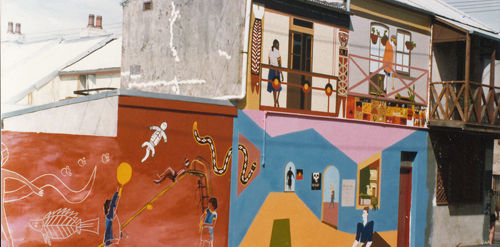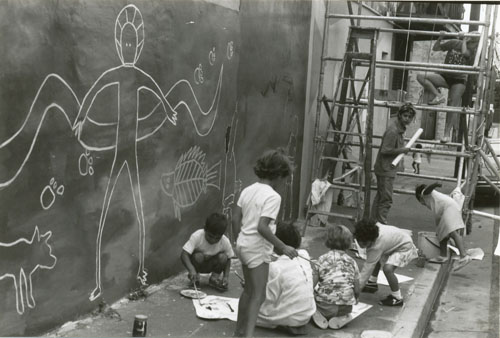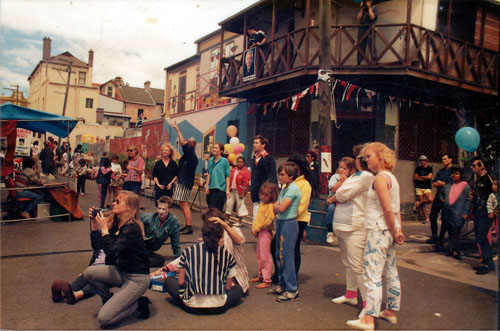|
|
Wednesday, January 7, 2026
|
|
|
|
|
SETTLEMENT MURAL PROJECT 1985
Project Artists: Fiona Foley, Avril Quaill
Assistants: Peter Hodgson. Michael Leslie Co-ordinator: Michael Adams
Documentation: Diane Losche

This project was completed with the generous assistance of: Aboriginal Arts Board of the Australia Council, Community Arts Board of the Australia Council, Federated Engine Drivers' and Firemen's Association, South West Inner Sydney Housing Co-op and also Joe Owens, Lindsay Danes, Colin James, Geoff Weary, the staff of Darlington Public School and the tenants of the Settlement houses.
__1. The Project.__
The Settlement Mural Project was a community arts project aimed at designing and painting a mural which reflects the local community.The mural was located on a wall of No. 1 Edward St., a house owned by the Settlement, leased to the South West Inner Sydney Housing Co-op (SWISH) and sub-leased at the time to Rhonda Spiller, a single mother with four children. The mural formed part of the northern boundary of the Settlement property and partly enclosed the Settlement yard.
The design and painting of the mural was carried out by two artists, Fiona Foley and Avril Quaill, with the assistance of local residents, particularly children. The project was coordinated by Michael Adams, Settlement Coordinator. A number of organizations contributed financially or materially to the mural. The SWISH Co-op contributed costs for preparing and undercoating the wall. Scaffolding was donated through the Federated Engine Drivers' and Firemen's Association. The major financial assistance of $6,450 came from the Aboriginal Arts Board and the Community Arts Board of the Australia Council.
__2. The Idea.__
The mural was suggested by Joe Owens (Federated Engine Drivers' and Firemen's Association) who was a tenant of No. 1 Edward St., at the time but the idea of a mural on that wall has been discussed by Settlement workers for years. Once conceived, the idea received support from many others. The tenants of other Settlement properties had talked about the mural and the idea had the support of the Board, tenants and workers of the SWISH Co-op, who head-lease the property. The project also received enthusiastic response: workers in other local community agencies; other Edward Street residents, and the South Sydney Building Workers' Collective and workers from the Visual History of South Sydney Project (V.H.S.S.P.).
__3. The Site. __
In 1984-85, 1 and 3 Edward Street were completely renovated under a Community Employment Program grant, then leased to SWISH, a community housing group which aims to provide low-income housing. This end of Edward Street tends to be the place where people sit out on their doorsteps and chat, wander in and out of each other's houses, where kids play on the footpath and street and where there's lots of noise and life. The renovation and tenanting of the corner residences has improved the atmosphere at this end of Edward Street. It was hoped that the mural would provide a positive statement of this change as well as emphasizing the area's neighbourhood characteristics.
The area immediately surrounding the mural includes Edward, Vine and Cleveland Streets in which are located the homes of a very urban neighbourhood, a mixture of older white working class people, young working class families, Aboriginal people, middle class professionals and students. The Settlement also attracts a number of people, kids (mostly Aboriginal 0-20 years), Settlement workers and management and workers from other local organizations. It was envisioned that these would be the people most actively involved in the mural project. It was hoped that the mural would help in developing some community identity by providing a focus of attention and would make residents more aware of the Settlement, its services and its functions in the community.
__4. The Plan. __
The planning and co-ordination of the Mural Project was carried out by Michael Adams, Settlement Coordinator. The major aspects of this planning involved getting local government council approval for the mural, obtaining funding for the project, locating artists to design and paint the mural and coordinating the design and painting.
Although funding for the project turned out to be relatively straightforward (the Project was largely funded by the Aboriginal Arts and Community Arts Boards) getting Council approval turned out to be anything but and involved much paper work and delays. The mural was eventually approved with the assistance of Lindsay Danes, Community Arts Officer of the Sydney City Council.
__5. The Artists. __
The mural was designed and painted by Avril Quaill and Fiona Foley, two Aboriginal artists with previous mural experience. The artists were contacted through the Visual History of South Sydney Project (which was financially administered through the Settlement). The artists brief was not only to design and paint the mural but also to research the views of the immediate community and other relevant groups on the content and design of the mural and to encourage as much participation and consultation as possible. Their work also included purchasing equipment and paint, finalising the design and supervising the painting of the mural by interested people in the community. The artists printed a leaflet explaining the project, which they distributed to local residents.They also went on a door knocking campaign to encourage community participation.Both Fiona and Avril felt that this phase of the project was not very successful. Many residents seemed either uninterested, defensive or hesitant about expressing their opinion. Whether this was a response to the mural or to door-knocking strangers they couldn't tell. (leaflet to come)
The artists also collected visual material (old photos etc.) from the Settlement in order to get ideas for the Mural design. Children from Darlington Primary School were given paint and paper at the Settlement one day and their resulting pictures were plastered around the Settlement workroom, where Avril and Fiona worked on the design, as part of the ‘inspiration’. While Fiona and Avril were designing the mural and supervising the children’s drawings, ten Pitjantjatjara women visited the Settlement to demonstrate their art and dance skills. They worked with Avril, Fiona and the children from Darlington School for one day and further inspired the atmosphere in which the mural design was created. Despite the initial lack of response by community residents, when the painting of the mural actually began it attracted quite favourable comments from many residents and passers-by especially from the children who go to the Settlement in the afternoons. Both artists felt that working with the community and the kids had been a very useful experience.

__6.____ Painting the Mural.__
Each artist designed a certain section of the wall. It was decided not to paint one small second storey section of the wall which faced Cleveland Street because the resident of 1 Edward Street decided that she didn't want the mural to be visible from her back garden (aside from this she expressed approval for the mural). The design was done on graph paper in the Settlement workshop and was transferred to the wall by the grid system (drawing a scale grid on the wall very precisely and then transferring the design to the wall by drawing the design by hand).
The artists were assisted by Peter Hodgson, an Edward Street resident and student at Sydney College of the Arts (as was Fiona Foley); and Michael Leslie, a graduate of Aboriginal Islander Dance School and the Alvin Ailey Dance School, who has also worked with Settlement kids in art projects. As the painting progressed some community residents came along to help paint and children were particularly enthusiastic about the painting. On some afternoons gangs of small girls and boys would descend on the painters, grabbing brushes and ready to add their contribution. Unfortunately it was too difficult for the artists to supervise these very enthusiastic efforts enough to ensure quality control. Despite this the artists wanted the kids to give some contribution to the mural so it was organized with Darlington Primary School to have kids come in small groups with their teachers to paint some of their own design on a small designated section of the mural wall. This entailed some anxiety as the enthusiastic painters clambered up the scaffolding to paint their 2nd storey contributions. All went well; no one fell off and the mural has a small section of the children’s contributions. by Diane Losche

the Chippo Festival in 1987 |
|
|
 |
|
|
|
|
|
|
 |
 |
| |
Terms Of Use
|
Privacy Statement
|
Copyright (c) 2026 Redfern Oral History
|
Register
|
Login |
Website Solution: Pixel Alchemy
|
|